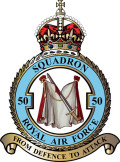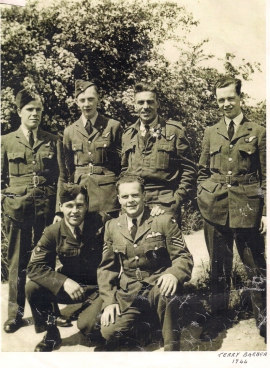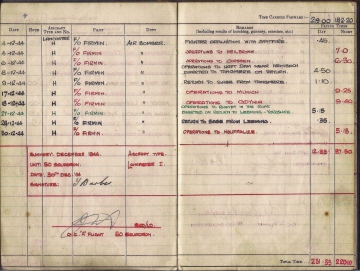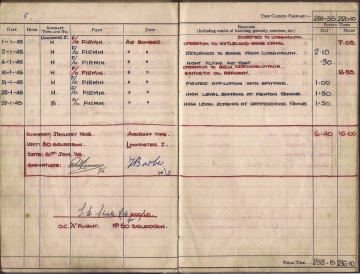Warrant Officer Terry Barber
Terry Barber was born in Liverpool on 1st February 1923. On leaving school he went into the joinery business before volunteering for the Royal Air Force.
Selected for flying training he did his elementary flying training at N0.29 EFTS at RAF Clyffe Pypard in Wiltshire in 1943. His training aircraft was the DH82 Cornell, in which he did 18 hours of tuition before doing his first solo flight. his instructor at the time were F/O Styles and Sgt Thomas.
At the end of his elemenatary flying training he had completed a total of nearly 76 hours of flying of which 30 hours was solo.
This was in April 1943 and at this time it was explained to him that they were short of other crew members and suggested that he should transfer to another job.
In June of 1943 LAC Barber commenced training as an Air Bomber, and Air Gunner at No.7 Bombing and Gunnery school RCAF Portage la Prarie, flying in Anson and Bolingbroke aircraft, completing 53 hours day and 8 hours night training and qualifying as an Air Bomber/Gunner on 3rd September 1943.
Training continued from early September to mid October 1943 in the Anson during which time he also qualified on navigation.
Transferring back to the UK his training continued at 90 AFU, at Penrhos, again in the Anson. during this time he also flew from Llandwrog. This was from 15th February 1944 to 20th March 1944 completing further bombing and navigation training.
From here he transferred to 29 OTU at RAF Bitteswell training as an Air Bomber in the Wellington. completing 40 hours day and 41 hours night flying. It was here that he met up with his to be operational skipper Bill Fermin
From here it was on to 1661 HCU at RAF Winthorpe, involving further training in the Stirling heavy bomber. The majority if his flying being with Bill Fermin.
3rd September 1944 saw him arrive at No.5 L.F.S. at RAF Syerston, during which time he flew with Flt/Lt Ken Ruskell and Sergeant Firmin.
The crew made up, they were then posted to No.50 Squadron at RAF Skellingthorpe for operations.
Terry Barber (Bomb Aimer, back right) and his crew, his skipper Bill Firmin front centre. Gordon Bulmer (Flight Engineer) kneeling next to him.
Other crew are;
Reg Hughes Mid Upper Gunner
Don Smith Wireless Operator
Larry Whatts Rear Gunner
Bert Bright Navigator
Terry affectionally became known as "Ali Barber" by the rest of the crew.
On arrival at Skellingthorpe, with their skipper now promoted to Flying Officer, their tour of operations began. Leaving Syerston on the 12th they arrived at Skellingthorpe on the 13th, and straight into familiarisation. In the first two week after arrival they flew six operations, one day raid and five night raids. The first raid, in daylight was to boulogne to attack german positions in preparation for an attack by allied troops. The raid to Rheydt was the raid that Wing Commander Guy Gibson was master bomber and which he failed to return.
November saw them carry out seven operations, two Daylight raids and five night raids. the first raid of the month, a daylight raid, was to Homberg to attack the Meerbeck oil plant. The Dusseldorf raid of the 2nd november was the last major raid of the war on this target. At this time most of the raids were in support of the invasion and the targets were the canal system used to re-supply the German forces, Ladbergen and Gravenhorst. The raid to Duren was in support of the American First and Ninth Armies to cut communications behind enemy lines.
Now into December and a further seven operations, two daylight raids and five night raids. The first two night raids of the month were to railways lines and yards at Heilbronn and Giessen. This was followed by a daylight raid to the Urft dam then Munich and a night raid to Gdynia on the baltic coast, followed by a further raid to the railways yards at Rheydt. New years eve saw them carry out a night op to Houffalize to attack a German supply bottleneck in the narrow valley.
February saw them carry out six raids in the month, all at night. The Seigen and Karlsruhe raids were largely ineffective because of cloud cover. The synthetic oil plant at Politz however proved to be extremely accurate, with severe damage to the plant. The raid to Desden on 13th February caused devestation in the city. Further attacks on oil refineries at Rositz and Bohlen were made.
March 1945 saw them complete their tour with raids to Bohlen again and Sassnitz on the baltic, followed by two daylight raids to Essen and Dortmund. These raids used Oboe directed sky markers and proved to be very accurate.
THis completed their tour of 34 operations.
On 9th April 1945 Terry joined 84 OTU flying Wellingtons as Screen Air Bomber, completing his final flight on 6th May 1945
Acknowledgments to Bomber Command Diaries by Martin Middlebrook for details on raids













